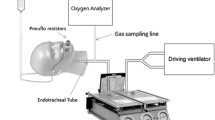Abstract
Purpose. The DrÄger Cato anesthetic machine (DrÄger, LÜbeck, Germany) effectively humidifies and warms anesthetic gases, because it has a built-in hotplate to heat the breathing system, and expired gas passes through the CO2 absorbent three times during one breath. In the present study, we measured the temperature and absolute humidity (AH) of the anesthetic circuit in the DrÄger Cato machine with and without heat moisture exchangers (HME), and compared them with those in another anesthetic machine, the Aestiva/5 (Datex-Ohmeda, Helsinki, Finland).
Methods. Forty-eight adult patients were randomly assigned to one of eight groups according to the anesthetic machine, fresh gas flow (FGF), and the use of HME (n = 6 each): Cato 0.5 l·min−1 without HME (group 1), Cato 1.0 l·min−1 without HME (group 2), Cato 0.5 l·min−1 with HME (group 3), Cato 1.0 l·min−1 with HME (group 4), Aestiva 0.5 l·min−1 without HME (group 5), Aestiva 1.0 l·min−1 without HME (group 6), Aestiva 0.5 l·min−1 with HME (group 7), and Aestiva 1.0 l·min−1 with HME (group 8). The temperature and AH of the anesthetic gases were measured with a Moiscope (S.K.I. Net, Tokyo, Japan), which was placed between the endotracheal tube and the Y-piece of the anesthetic circuit. The HME was placed between the Moiscope and the Y-piece of the anesthetic circuit. The temperature and AH of the anesthetic gases were measured at 5, 10, and 15 min and then every 15 min up to 150 min after tracheal intubation.
Results. Among the groups without HME (groups 1, 2, 5, and 6), the inspired temperatures and AH in groups 1 and 2 were significantly higher than those in groups 5 and 6 at all times during the study period (P ≪ 0.01–0.001). The inspired temperatures and AH of the groups with HME (groups 3, 4, 7, and 8), were significantly higher than those in groups 2, 5, and 6 (P ≪ 0.01–0.001). Among the groups with HME, the AH in group 3 was significantly higher than that in group 8 until the final study period.
Conclusion. The present study indicates that the DrÄger Cato machine was more effective in warming and humidifying respiratory gas than the Aestiva/5, and that Aestiva/5 without HME does not reach the optimal temperature and humidity ranges, even if minimal flow anesthesia (0.5 l·min−1) is performed.
Similar content being viewed by others
Author information
Authors and Affiliations
About this article
Cite this article
Wada, H., Higuchi, H. & Arimura, S. Temperature and humidity of the DrÄger Cato anesthetic machine circuit. J Anesth 17, 166–170 (2003). https://doi.org/10.1007/s00540-003-0174-8
Received:
Accepted:
Issue Date:
DOI: https://doi.org/10.1007/s00540-003-0174-8




